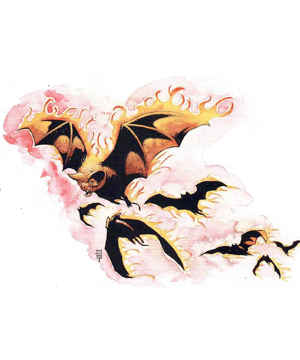Fire Bat

Fire Bat
2119

| Climate/Terrain: | Elemental Plane of Fire |
|---|---|
| Frequency: | Common |
| Organization: | Pack |
| Activity Cycle: | Any |
| Diet: | Blood |
| Intelligence: | Semi- (2-4) |
| Treasure: | I |
| Alignment: | Neutral evil |
| No. Appearing: | 10+1d10 |
| Armor Class: | 8 |
| Movement: | 6, Fl 21 (B) |
| Hit Dice: | 2 |
| THAC0: | 19 |
| No. of Attacks: | 1 |
| Damage/Attack: | 2d4 |
| Special Attacks: | Heat, blood drain |
| Special Defenses: | Reform body, immune to fire, detect invisible, infravision 120 |
| Magic Resistance: | Nil |
| Size: | S (2 long, 4 wingspan) |
| Morale: | Average (8-10) |
| XP Value: | 175 |
As if the concept of animentals wasnt interesting and strange enough, the intriguing little fire bats take things a step further. Theyve evolved. Fire bats are more than just bats made of fire though to a casual observer, they probably appear to be just that, and nothing more.
First of all, theyre surprisingly intelligent. They hunt in packs and fight with a cunning that no terrestrial bat could ever develop. Second, their form and nature distinguish them from both normal bats and pure elementals. The creatures appear relatively batlike but are 2 feet long with a 4-foot wingspan. They arent comprised entirely of fire but have physical bodies that burn with a steady, super-hot flame. Red-tinged fire bat skin is leathery and tough, moreso than a normal bats even their thin wings are difficult to cut or pierce.
Fire bat flight also differs from that of normal bats: They dont glide, but instead propel themselves with the heated gases expelled from their own flames. They can even fly through fire and magma. Unlike other bats, fire bats prefer well-lit areas to darkness, although theyre able to see perfectly well in both (they have 120-foot infravision). Their enhanced sonarlike ability allows them to detect even invisible creatures and objects.
The most dramatic difference, however, between fire bats and normal bats is that the former are immortal. When reduced to 0 or fewer hit points, fire bats reform as small balls of flame elsewhere on the Elemental Plane of Fire, eventually regaining their original form. This is true even on their home plane, though few primes realize it. Seemingly nothing except certain spells can decrease the number of fire bats on the plane of Fire. Between this ability and their method of reproduction (see Ecology below), fire bats have the potential to someday engulf the entire plane.
Combat: In combat, a fire bat swoops down and bites its foes, draining blood and burning them at the same time (both the bite and the burn indict 1d4 points of damage, for a total of 2d4 points per attack). A successful hit in combat indicates that the fire bat has latched onto its prey and does not need to make further attack rolls to inflict more damage. Each round it drains more blood and burns the victim further. (Victims immune to fire still suffer 1d4 points of damage from the bite and blood drain.) After three rounds of draining, the fire bat drops off its victim, sated with blood. If the victim dies before those three rounds are over, the fire bat attacks other victims in order to finish feeding.
A fire bat pack always divides up its attacks equally among a group of opponents. If 25% or more of the packs attacking numbers have been reduced through casualties or by sated bats, the pack flees. But that doesnt mean that whatever prey is left is safe. After the bats recover from their losses, the pack returns and hounds its opponents, making further attacks until all have had their fill or until the prey is completely dead. Since sated bats produce more of their kind (see below), a greater number of beasts may return than were in the original pack.
Immersing a fire bat (even briefly) in 10 or more gallons of water extinguishes its flames. It takes a fire bat 10 rounds to reignite its flames. Without its flames, the bat cannot fly and inflicts only 1d4 points or damage.
As stated above, a slain fire bat simply reappears somewhere on the plane of Fire. To permanently destroy a fire bat, a body must cast affect normal fires, dispel evil, dispel magic, or protection from fire on the creature, and then kill it. Also, slaying an extinguished fire bat (by any means) has a 75% chance of permanently destroying the creature.
Habitat/Society: Fire bats have propagated to the point where the Elemental Plane of Fire is quite filled with them. The bats maintain a good relationship with fire elementals and frequent areas where these creatures are found. Fact is, they sometimes dwell within fire elementals and feed upon the creatures that the elementals consume. Sometimes, when a wizard or priest summons a fire elemental, the fire bats within it accompany the summoning. This is bad for the summoner, for while he has control over the elemental, the spell or device used most likely holds no sway over the unexpected fire bats.
Fire bats are enemies of salamanders, efreet, and many other creatures of flame, preying on them as they are in turn preyed upon. Nevertheless, they are occasionally encountered with such creatures, enslaved as guardians through magic common to the plane of Fire.
Ecology: Fire bats gorged on blood reproduce by splitting into two distinct, adult individuals. This process takes about a day. Once it has reproduced, the bat cannot do so again for up to a year. During this time, the fire bat is only 50% as likely to attack and feed as those capable of reproduction.
Last Modified: April 22, 2009, 13:50:46 GMT

◆ 691 ◆




 Published by
Published by